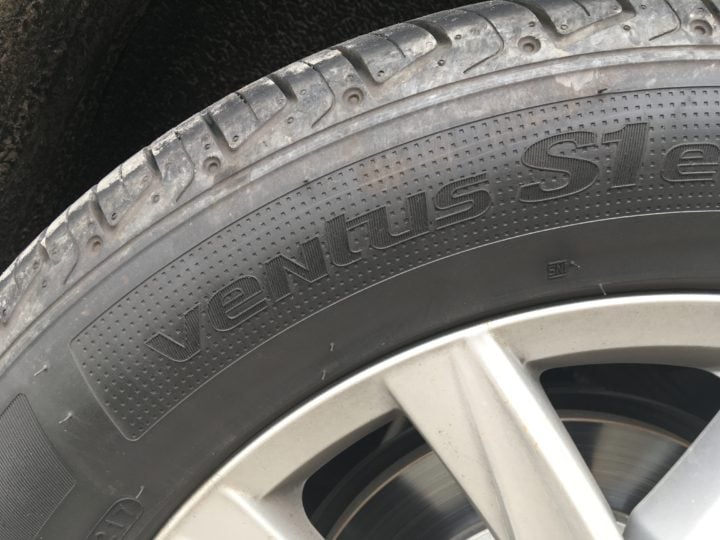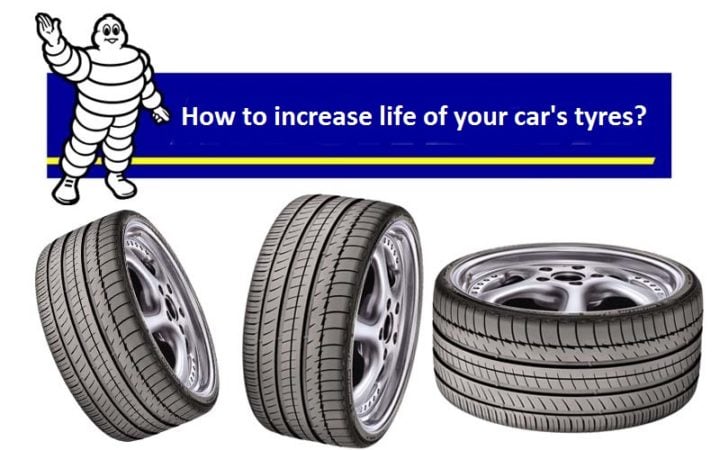A car’s tyres are more than just some rolling components. For example, if you consider your car’s ride to be comfortable, do note the tyres help with that aspect. Similarly, when you take your car for a spin on curvy roads, remember that tyres play an important role there too in helping your car handle like a champ. These are just some instances to show how important a car’s tyres are. However, tyres do have a lifespan. You will have to replace them someday. But do you know when to do so? Here are some pointers to tell you when to change car tyres.

When to Change Car Tyres?
#1: Worn out tread
Why: Passenger cars have tyres with tread on them. This enables you to use you car in a variety of road conditions, dry or wet. However, over time, the tread wears thin. A tyre with tread throws water on roads away from the vehicle. A tyre low on thread keeps pushing water in front of it, causing the car to ride on water (hydroplane) and even skid. Many car tyres today feature tread wear indicators to help you know how much the tread has worn out. Always keep an eye on that. A fast reducing tread is a clear sign of when to change you car tyres.
If you car’s tyre does not have a tread indicator, take a coin and dip it in one of the tread grooves. Using this trick regularly will help you know when it is time to change your tyre. Do note that using the same size coin always will help you know how much the tyre tread has worn out.
#2: Uneven wear pattern
Why: Uneven tread wear takes place when you frequently brake and/or accelerate your car hard. This tends to wearing a portion of the tyre more than the rest. You can determine this by taking a look at the tyre. A portion of the tyre will have shallower grooves than the rest. That’s your cue to either stop accelerating and/or braking hard or look for a new tyre.
Another cause of uneven tread wear pattern is incorrect tyre inflation. When you over-inflate a tyre, its centre portion expands more than the shoulder, causing more wear on the inside portion of tyre than outside. Under-inflation causes more wear on shoulders than centre portion. This reduces your car’s grip in turns, something you do not want to witness. Excessive wear on either portion means time to replace the tyre.
#3: Sidewall damage
Why: This is one of the most crucial sign to watch for before you can change car tyres. Sidewall damage on a tyre is the last thing you will want to see. Why? The sidewall of a tyre is stronger than other parts of the tyre. After all, it has to support the weight of the car. So, any damage to a tyre’s sidewall should be taken quite seriously. If you see a crack, bulge, blister or a bubble on the tyre’s sidewall, stop using it and get it replaced quickly. Using the said tyre will result in tyre failure and it may lead to something bad such as a blowout while driving the car, resulting in an accident.
#4: Wheel misalignment
Why: Wheel misalignment is a reason why tyres wear out prematurely, hence the need to change car tyres arises. If the wheels are not aligned properly, one or more tyres are excessively taxed during daily driving. How so? Misaligned wheels may, for instance, make your car veer in one direction instead of going straight. This can lead to things like tyre feathering (meaning tyre is smooth on certain parts only) and either shoulder having more wear than centre portion of the tyre.
As you can see, when to change car tyres depends a lot on how you use the car and careful observation of the tyres. There are a number of times when you can just tell by looking that time is ripe to change car tyres. Such times have been mentioned above.
How to increase life of car tyres?
However, you can maximise or enhance car tyres life. All it requires is for you to observe a few things, that’s all. Here’s how to increase life of car tyres.
#1: No sudden braking/accelerating
Why: This will help reduce excessive wear and tear on certain parts of your tyre. enhancing its life. Even tyre wear will help in getting the most out of your car’s tyres. Hence, you will be able to scratch the change car tyres task for the foreseeable future.
#2: Proper inflation
Why: We have told you about the effects of improper tyre inflation. Inflating your car’s tyres up to recommended pressure level will help spread wear and tear on the entire tyre instead of certain bits only. This will not just elongate the tyres’ lifespan but also enable you to enjoy driving your car when going fast in a straight line or tackling a twisting road.
#3: Regular alignment
Why: Regular alignment has a few benefits to offer. First, it helps reduce the uneven wear and tear on one or two tyres. Secondly, it helps you know if there are parts of your car at fault for tyre misalignment, such as damaged axle. This way, you can be sure your car’s tyres have a long lifespan. Long lifespan means no need to change car tyres early on.
#4: Tyre rotation
Why: Tyre rotation refers to mounting your tyres on other mounting areas than where they were earlier. This helps in spreading the wear and tear on other tyres which are relatively in better condition. Also, a side benefit of this practice is that your car’s spare tyre will also come into regular use.
Using the spare tyre regularly will do two things for you. Firstly, all of the tyres will come into duty. Secondly, if there is any issue with the spare tyre, it will come to fore at the earliest. When you replace your car’s tyres, you will replace the spare tyre, which is good practice as far as enhancing car tyres life is concerned.
#5: Using OEM-spec tyres and wheels
Why: When a car is made by automakers, tyres and wheels are also tested thoroughly. If you use different size wheels and tyres, they will not just affect tyres’ life but the car’s dynamics too. Using a wider set of wheels or low sidewall tyres may make your car look great. However, both will have an adverse effect on tyres’ life specifically and car’s dynamics generally. So, be very careful of such practices.
Conclusion
The signs mentioned in this article are more or less what you should watch out for to know when to change car tyres. Using the tips to enhance the tyres lifespan will help you keep the tyre changing routine at bay for a long time. This not just benefits your pocket but also lets you enjoy driving your car for long. Now, that is worth some effort, isn’t it?
So above are a few tips on when to change car tyres and also on how to increase life of car tyres. We really hope you find this post helpful. Please feel free to drop in feedback in the comments section below. Stay tuned for more posts like the ‘when to change car tyres’ post we have here.



